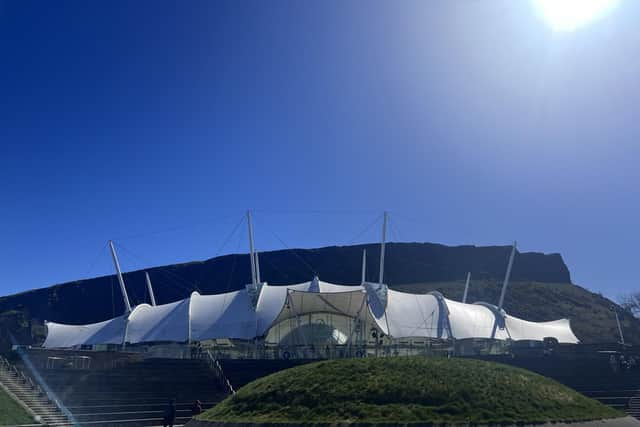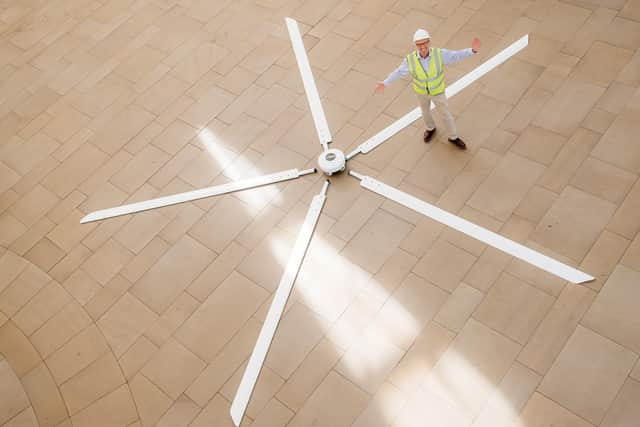Science fans: How Scottish museum of the planet is helping save earth from climate change
The giant device is part of a new system being fitted at Dynamic Earth museum and science centre to improve energy-efficiency and achieve national environmental targets.
The landmark building, a near neighbour of the Scottish Parliament and Holyrood Palace, is characterised by its unique ‘tent-style’ dome structure – known as the stratosphere – and grounds featuring an open-air amphitheatre.
Advertisement
Hide AdAdvertisement
Hide AdErected on the site of a former brewery and incorporating part of the original building, the not-for-profit environment-focused exhibition and events hub was created as one of the country’s millennium projects.
Opened by the Queen in 1999, it continues to attract around 250,000 visitors each year and holds a gold award for Green Tourism.
It has also won accolades for its iconic architecture.
But the stratosphere, constructed from a fabric membrane stretched over a steel skeleton and surrounded by glass walls, is difficult to heat and cool.
Now, thanks to a £190,000 loan from responsible finance provider Social Investment Scotland (SIS), the charity has begun a major project to improve the building’s heating system and reduce its carbon footprint.


The funds will be used to upgrade the airflow and lighting systems in the stratosphere and lighting in other areas of the building.
Collectively these renovations will result in significant energy savings, reducing usage by more than 200,000 kWh annually, and a cut in greenhouse gas emissions equivalent to more than 20 tonnes of carbon dioxide each year.
The new scheme, which involves the installation of five fans – including the monster destratification device, which will be suspended from the curved roof – will help to transfer warm air that has risen up to the roof space back down to ground level.
This will keep visitors warm and make use of energy that would otherwise have been wasted.


Advertisement
Hide AdAdvertisement
Hide AdEco-friendly LED lighting is also being installed within the visitor centre to cut energy use.
The moves will help align with Scotland’s target to reach net zero emissions by 2045 – five years ahead of the UK date to do the same.
Dynamic Earth chief executive Mark Bishop stressed the importance of action to minimise harmful environmental impacts, particularly for an organisation dedicated to the planet.
He said: “As the face of public engagement around the sustainable future of our earth, it’s vital that we ‘walk the walk’ and do the right thing by continuing to address our own energy challenges.


“What’s more, we are in a unique position to inspire other organisations to do the same, creating a catalytic effect for positive change.
“Heating and lighting are two of the biggest uses of energy in all of our homes and buildings but making seemingly small changes can have a big impact on your carbon footprint and the associated running costs.
“Dynamic Earth opened more than two decades ago and the available technology has improved significantly since then.”
Chris Jamieson, head of investment at SIS, added: “Dynamic Earth is a much-loved science and learning centre that, by its very purpose, is committed to preserving our planet’s resources.
Advertisement
Hide AdAdvertisement
Hide Ad“The new upgrades will not only help to reduce energy consumption but – just as critical in the face of a business-costs crisis – will allow for long-term cost savings.
“Supporting charities and social enterprises with funding to underpin their environmental ambitions will be key to future-proofing the third sector as we approach Scotland’s deadline for net zero.”
Attractions at Dynamic Earth include the Deep Time Machine, which allows visitors to travel back to the beginning of time and witness the ‘big bang’ first hand.
It includes interactive experiences, with a virtual spaceship flight rocketing through the galaxy at a rate billions of times faster than the speed of light and the chance to feel the earth move as volcanoes throw clouds of ash and gas into the sky and flows of molten lava spill across the landscape.
Polar ice caps are brought to within reach, allowing visitors to touch an iceberg, smell the cold and feel their hands turn numb while standing beneath the spectacular Aurora Borealis.
Exhibitions dive into the darkest depths of the sea to reveal little-known habitats and amazing discoveries. Scotland’s marine science pioneers – past and present – are also celebrated.
The Dynamic Earth planetarium runs a wide programme of films and live shows throughout the year.
Comments
Want to join the conversation? Please or to comment on this article.